
story by Allison Gorman and photography by J. Intintoli
A new school year was fast approaching, and airplanes had been coming in so frequently that MTSU’s Wendy Beckman had lost track briefly last fall. Two new twin-engine planes were due for delivery then, bringing the number of Piper Seminoles to five when they arrived. The Aerospace Department also was expanding its Diamond fleet to 39 planes after adding eight more single-engine Diamond DA40s in early 2023.
“We’re probably going to need more if the enrollment continues,” said Beckman, professor of Aerospace and former department chair.
She was referring to enrollment in Professional Pilot, the department’s largest concentration by far. Pro Pilot had surged from around 450 to 900 students since 2015, propelling a similar surge in Aerospace majors overall—from 650 to over 1,200 in the same time frame. Whenever an academic major doubles that quickly, the logistics of meeting the increased demand are challenging.
“We’ve hired every year,” said Tyler Babb, who coordinates the Pro Pilot concentration. “I can’t think of a year since 2013 that I didn’t serve on or chair a search committee for a new faculty member.”
But in Pro Pilot, the logistics of exponential growth go far beyond hiring new faculty or increasing classroom size (although they’re doing that too).
“There’s so much infrastructure required for a Pro Pilot student, in terms of flight instructor and aircraft and all that,” Beckman explained. “It’s not like adding a section of a history class.”
By the time Pro Pilot students graduate from MTSU, they have around 200 hours of flight time, if not many more. That means access not just to airplanes and flight instructors, but to airport space—an increasingly scarce commodity at landlocked Murfreesboro Municipal Airport, where the University has trained pilots since 1952.
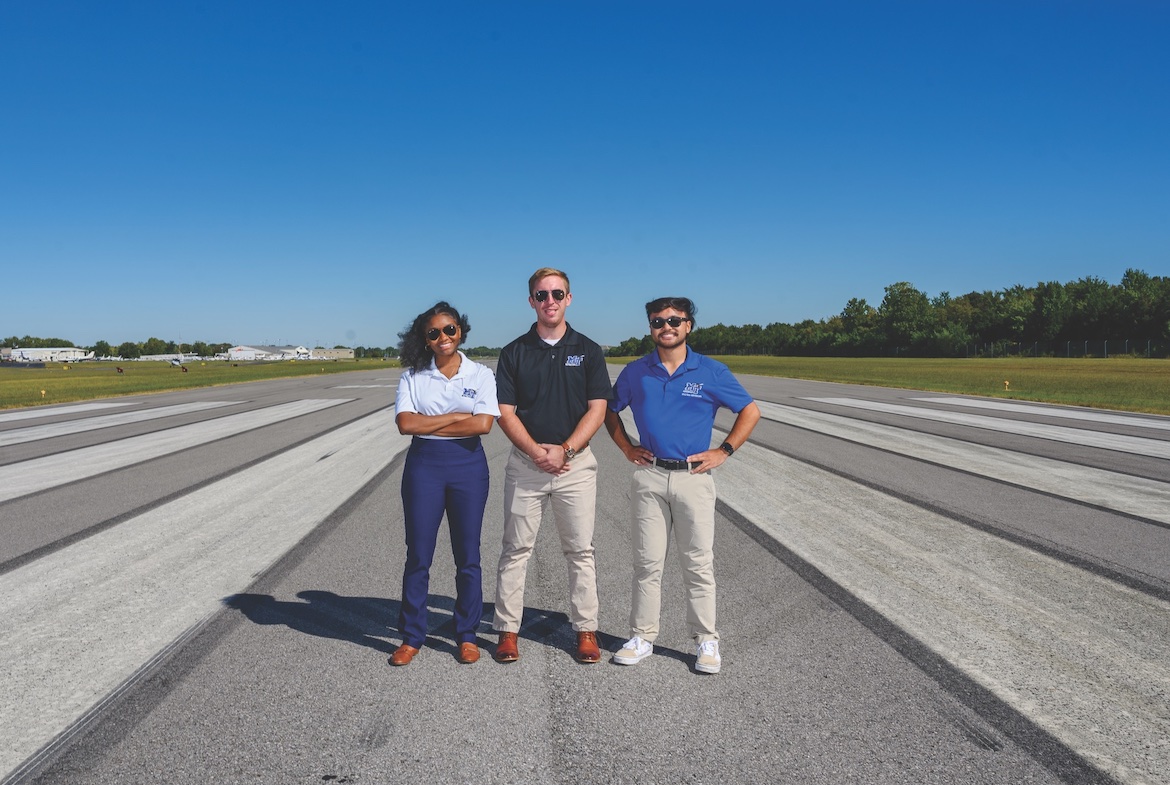
MTSU recent alumni (l–r) Farilyn Hurt, Connelly Pignocco, and John Paul Quiampang
So over the next three years, with $62.2 million in new state funding generously provided by the Tennessee General Assembly in 2022, Aerospace will move pilot training to the Shelbyville airport, where there’s plenty of room to expand.
All this growth is a direct result of demand from an industry that’s soaring after years of financial upheaval—years when carriers were going bankrupt, planes were grounded, and pilots were retiring early. By contrast, these days there’s a critical need for new talent at airports and airlines, and MTSU is making historic investments to meet that need.
MTSU has always been an integral part of the aerospace industry pipeline, with one of the most respected programs in the country. Veteran faculty members like Beckman and Babb, as well as Aerospace Chair Chaminda Prelis, who joined the University in 2021, have deep connections in the industry and broad experience navigating its ups and downs.
“As the Aerospace program marked its 80th anniversary in the past year, we are charting its future course,” Prelis said.
Achieving a Dream
MTSU’s Aerospace Department began as a campus-based flight-training detachment for the Army Air Corps during World War II. It moved to what is now Murfreesboro Municipal Airport, where it was briefly privately owned, then fell back into the purview of MTSU.
Over the following decades, MTSU Aerospace expanded its scope far beyond pilot training to include programs in Aviation Management, Flight Dispatch, Technology, Maintenance Management, and Unmanned Aircraft Systems (UAS) Operations, as well as three Aeronautical Science master’s options.
Currently, MTSU has seven Aerospace concentrations accredited by the Aviation Accreditation Board International —more than any American university except Embry-Riddle Aeronautical University. But Pro Pilot has always been its largest concentration.
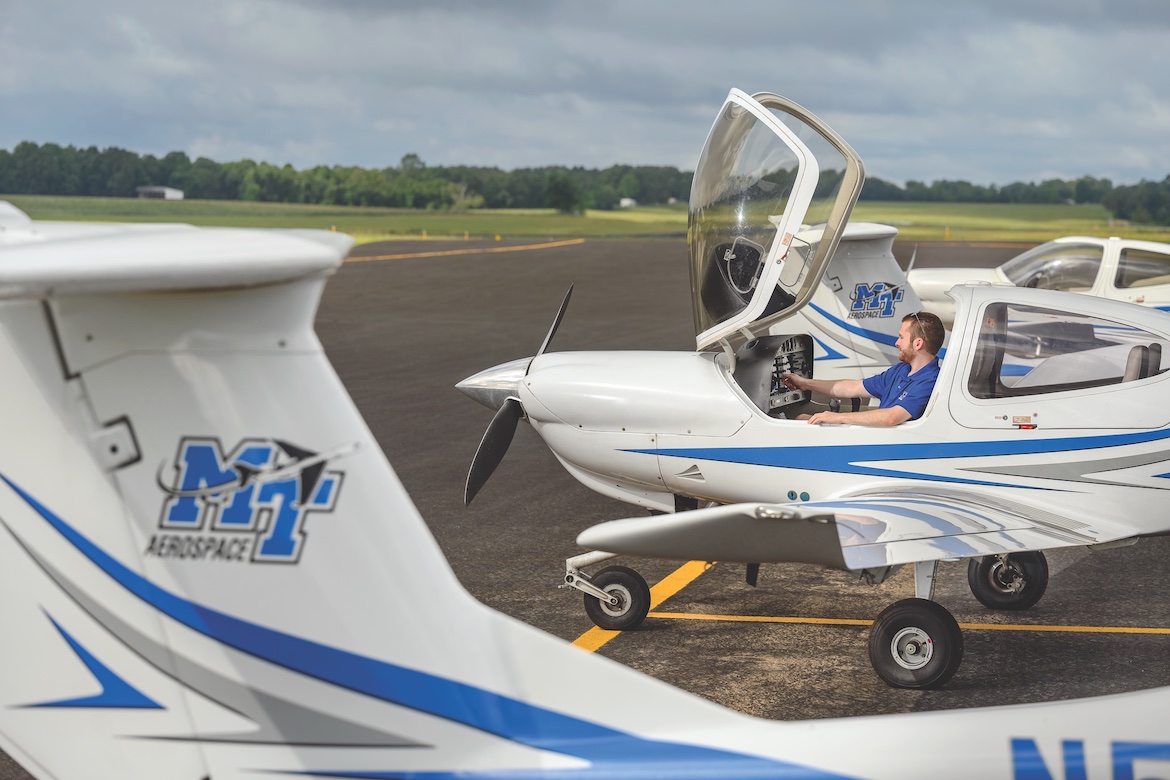
Alumnus and flight instructor Matthew Champagne with MTSU aircraft
A big part of that is the romantic appeal of flying. For many people, like Drew Perhac, being a pilot is a lifelong dream.
A Pro Pilot alum (’19) and now a Delta Air Lines pilot, Perhac was taking flying lessons before he could drive.
“It was kind of funny because my girlfriend at the time—my wife now—is older than I am, so she’d have to drive me to the airport,” he said. “I would go fly the airplane, and then she’d drive me back.”
His fellow Blue Raider and Delta pilot Colton Gray (’17) is quick to admit that he didn’t choose the career for the paycheck.
“It’s not something I do for the money—it’s something I’ve wanted to do since I was a little kid,” he said. “Don’t tell my employer, but I’ll almost do it for free.”
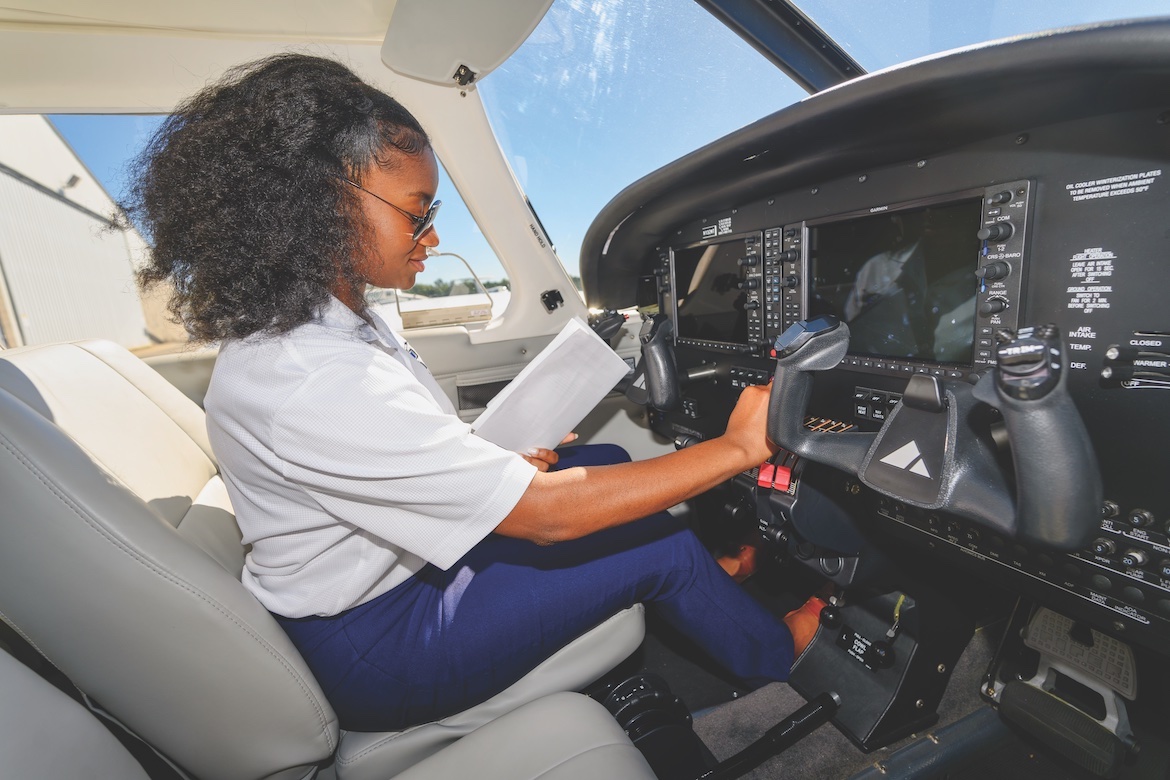
MTSU now boasts a fleet of 45 training aircraft.
Not long ago, working for next to nothing was a rite of passage for new pilots, Beckman said. They’d survive on low wages and poor sleep while putting in time with a regional airline—the prerequisite for getting hired by a major carrier and finally making a comfortable income.
“[Pro Pilot graduates] would come out and make $20,000 to $22,000 a year for their first couple of years at a regional airline. So students would hear that—we’re pretty honest in our Intro to Aero class—and they’d switch into other concentrations,” she said. “They’d decide that being a dispatcher or controller might make a lot more sense financially than going through this whole painful period for five, six, seven years as a regional airline pilot.”
The picture began to change when the airlines finally emerged from prolonged economic turbulence that started after 9/11. Pilots were able to leverage the increased demand for their services into better pay and working conditions, even at the regional level. Since then, Aerospace has been flooded with Pro Pilot majors who knew they could fly and make a living doing it.
These days there’s a critical need for new talent at airports and airlines, and MTSU is making historic investments to meet that need.
A Flying Start
A major sign that the clouds were lifting came in 2017, when Delta sought out partnerships with eight of the country’s top aerospace programs, including MTSU’s, to identify and develop good pilots.
Its new mentorship and training program, Delta Propel, would put participants from partner universities on a fast track to a career with the airline.
Propel cut that period to 42 months—an “unheard of” timeline when the program launched in July 2018, Wesley said.
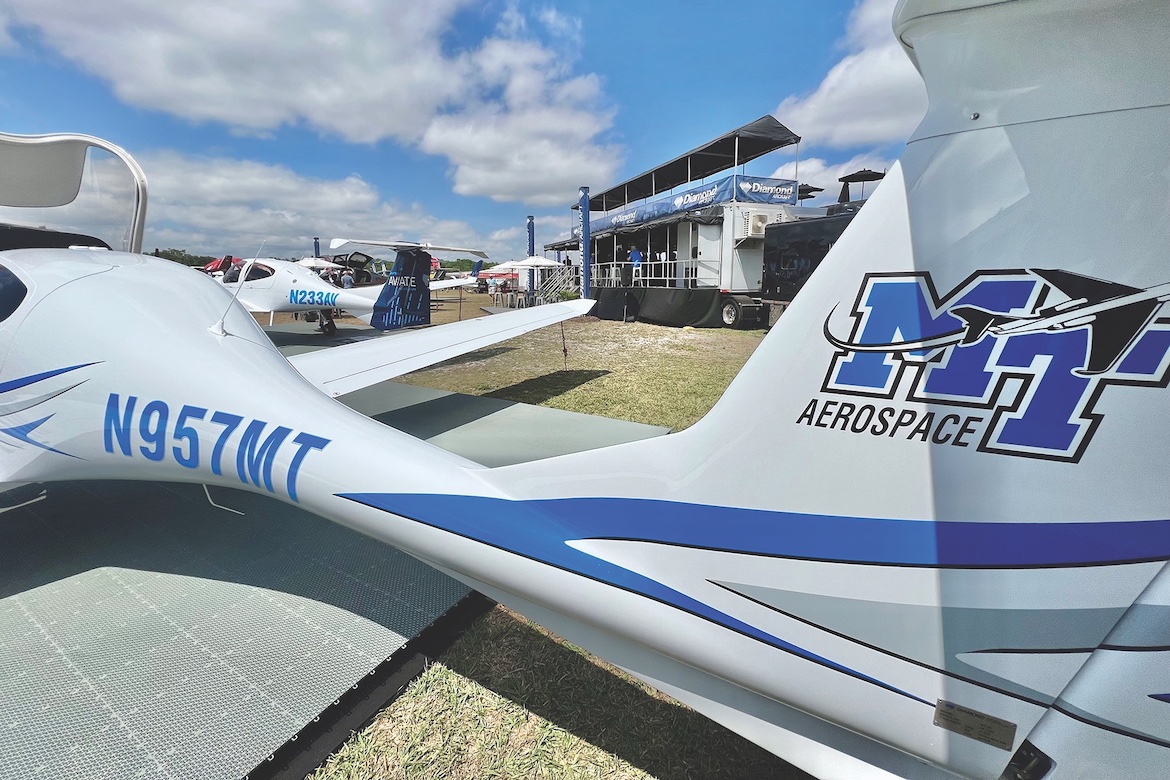
FLIGHT PATH: Commercial airlines are increasingly partnering with universities on entry-level career programs in an effort to attract ready-to-work talent into their fold. As one of the top aviation programs in America, MTSU has collaborated on two such partnerships—first with Delta Air Lines and more recently with Southwest. (Click to read more)
After serving as Propel’s liaison with MTSU from July 2018 through July 2022—and lead college liaison that last year—Wesley now serves as Propel’s lead mentor.
The mentorship aspect of the program is mutually beneficial, he said: Delta develops a personal relationship with pilots before they’re hired, and the pilots are familiar with the Delta culture when they come on board as first officers. During the 42 months, pilots can opt to fly private aircraft for Delta’s partner Wheels Up, fly for the military, or fly for a regional carrier.
Gray and Perhac were among the first participants to make it through the Propel program. Both chose the regional route, and both have been Delta first officers since summer 2022.
“Once you get to Delta, life usually becomes drastically better,” Perhac said. “Better pay, better quality of life, better work rules, so it’s been nice making that step.”
For the Pro Pilot student, Propel has “taken a lot of guesswork and uncertainty out of the career path,” Beckman said. “It’s amazing that somebody in college could eye their ultimate dream job, and there’s a clear path to that. . . . You don’t see that in any industry, right?”
That said, Propel is highly competitive. Beckman estimated that 16 to 18 of every 100 applicants from MTSU are chosen to participate. Propel’s proprietary selection process is based on metrics, not quotas, Wesley said, but of the 17 current Propel partners, MTSU is routinely among the top three or four for representation.
“MTSU is holding its own against large [aerospace] universities like North Dakota and Embry-Riddle,” he said.
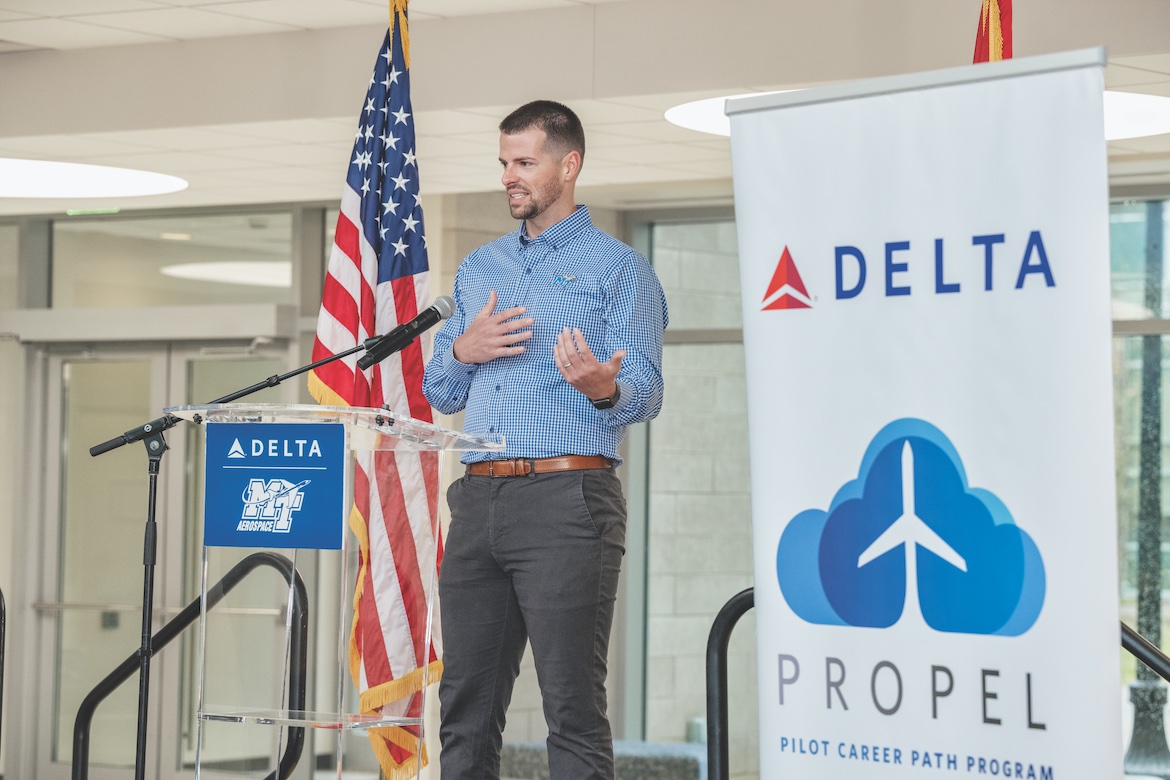
THE RIGHT STUFF: It’s no surprise that veterans gravitate to MTSU. The 3,200-square-foot Charlie and Hazel Daniels Veterans and Military Family Center—the largest such space at any higher education campus in Tennessee—speaks to the University’s tradition of serving those who’ve served. And it shouldn’t be a surprise that a lot of veterans land in Aerospace’s Pro Pilot program. (Click to read more)
First in Flight
In reality, MTSU’s Aerospace Department has been holding its own for years, especially when it comes to flight training.
For instance, Pro Pilot majors start flying almost immediately—either their first or second semester, depending on whether they come into the program with transfer credits. Babb, who used to recruit students from other universities, said that’s unusual.
“I used to hear all the time, ‘I’ve been here two years, and I haven’t touched an airplane yet,’ ” he said.
MTSU also stands out for its highly intensive first flight lab.
“Students have to fly four times a week,” Babb said. “It’s pretty fast, but we understand that, as with any training, it’s better to do it really often and finish in a shorter time window than to drag it out and fly once a week for six months.”
Airlines and airports are looking for new talent across the board.
During their third flight lab, students work toward their commercial pilot certification, awarded when a student meets FAA Industry Training Standards (FITS) rather than a certain number of flight hours. Paul Craig, an architect of MTSU’s flight-training program, adopted the FITS model around 2005, Babb said. Other universities have followed suit in recent years.
The FITS model is more cost-effective, Babb noted; good students can save more money by earning commercial certification in fewer hours. Most students are certified by the end of their sophomore year and work as part-time flight instructors at MTSU during their junior and senior years to get more flight hours. They can choose to go full time, and keep building hours, after graduation. Once they’ve hit 1,000 hours—usually within a year after graduation—they can apply for restricted certification to fly for a regional airline. Certification to fly for a major carrier requires 1,500 hours.
Students with a commercial pilot license also can build flight hours other ways, like crop dusting, skydiving, or banner towing. In fact, that’s where some students hope to land a career, Beckman said. The traditional “round-dial” planes with pneumatic gauges are still used for low-tech commercial applications.
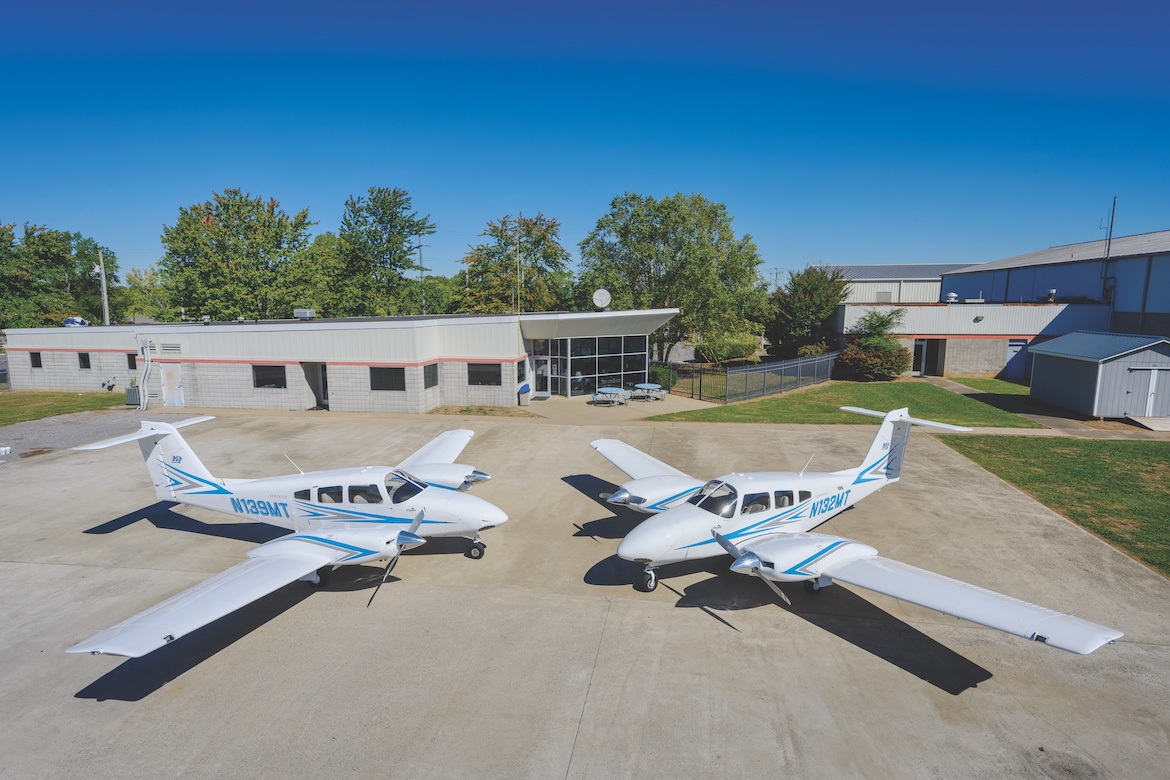
MTSU’s two new Piper multi-engine aircraft, bringing the total to five
But as Pro Pilot continues to grow, and with most students planning to go into transport, Aerospace has been steadily refurbishing and expanding its fleet of “glass-cockpit” aircraft like the Diamond Stars, which have integrated navigation and instrumentation systems.
The department is also investing in human capital, Prelis said. In addition to attracting new faculty from academia and industry, it just expanded its base of flight instructors from 80 to 100 and increased their pay. There are similar pay raises in the works for faculty and staff.
Babb said the program has been in a continuous state of expansion since he joined the faculty 10 years ago.
“The scale at which we’re operating is completely different—the number of flights going out in a given day,” he said. “A certain class that I used to teach always had 30 people in it, and [now] it’s got over 100.”
The new Aerospace complex at Shelbyville Municipal Airport, in nearby Bedford County, will accommodate growth in every direction, with an 83,000-square-foot academic building, three hangars, car parking, and an aircraft apron and taxiway.

FUEL FOR FLIGHT: The MTSU Aerospace campus at the Shelbyville Municipal Airport in Bedford County promises to generate tens of millions of dollars in revenue and hundreds of jobs for that community over the next three years, according to a recent economic impact study. (Click to read more.)
Prelis hopes to make those operations as environmentally sustainable as possible. His plans include a free shuttle between MTSU and the Shelbyville airport, a half-hour away.
“There’s really nothing much around that airport; it’s mostly farmland,” Prelis said. “And so not only will we have the capacity to establish what we currently need, but we’ll also have the space to continue growing.”
The state’s robust investment in the Shelbyville project is “a huge endorsement of what we do and of our program,” he said.
Sky’s No Limit
MTSU Aerospace attracts plenty of private investment too—from monetary contributions to hands-on help from alumni who teach as adjuncts. That continued support, public and private, allows Aerospace to respond quickly to an ever-shifting landscape.
“We engage with the industry,” Prelis said. “We ask them what types of skills they anticipate needing from our students, and we evolve our program to meet those needs.”
The increased demand for pilots is just part of it, he added. Airlines and airports are looking for new talent across the board.
Beckman said it’s time to start direct-recruiting high school students to those lucrative, lesser-known concentrations.
“There may be people who don’t want to be a pilot but would love the idea of running an airport—if they knew there was such a thing as aviation management,” she said.
Right now, conditions are perfect to be in aerospace, she said. Choose your destination.
SPACE TO GROW
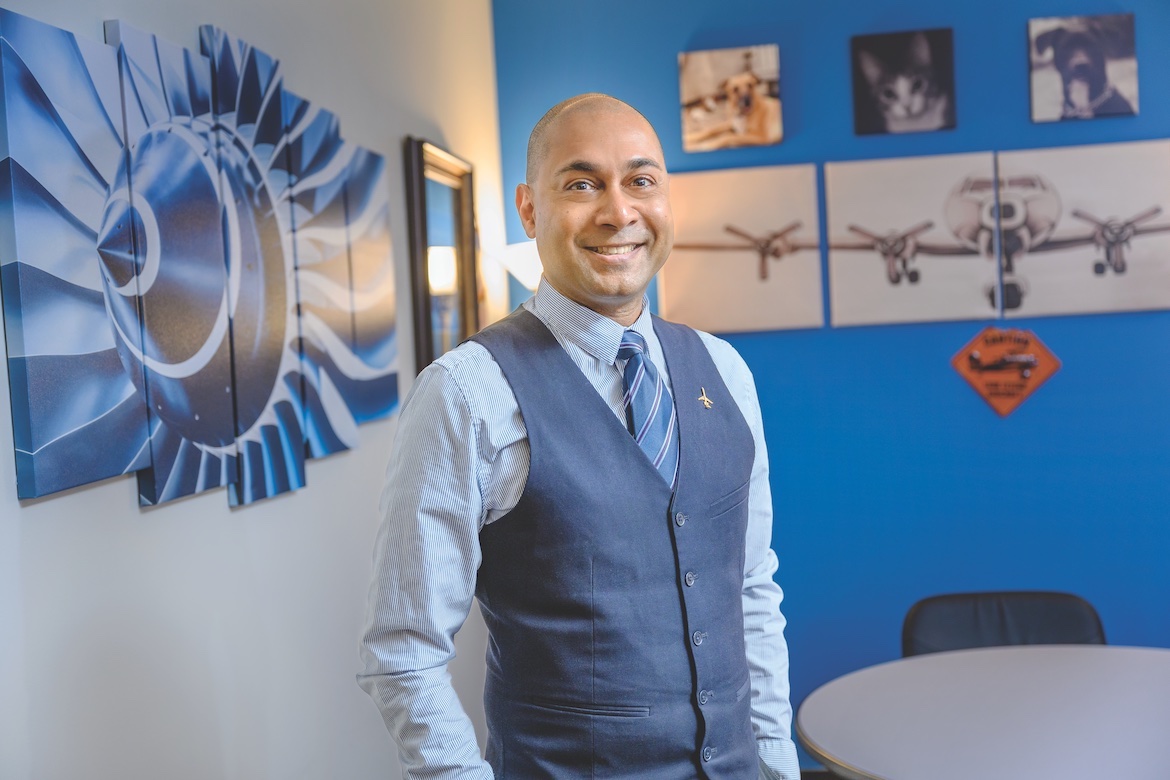
Aerospace Chair Chaminda Prelis
As the product of the University of North Dakota, Chaminda Prelis recognized the qualities of a top aerospace school.
When offered the position of MTSU Aerospace chair in 2021, he saw lots of reasons to accept: faculty like Wendy Beckman and Paul Craig involved with industry and research; success of the program’s students; and MTSU’s innovation in aerospace education—“where we have the greatest potential to leave our mark on the industry.”
Now Prelis is developing a 10-year plan to help the rapidly growing Aerospace Department meet the future needs of students and a constantly evolving industry.
In addition to significant human and capital investments, he and his veteran faculty are considering nonmonetary changes like expanding the curriculum—“making it more relevant for more people”—and offering more virtual classes, particularly in Aviation Management.
“Let’s say you’re a pilot or you’re an airport manager, and you’re already out there in industry, you wouldn’t have to come to MTSU to get that degree,” he said.
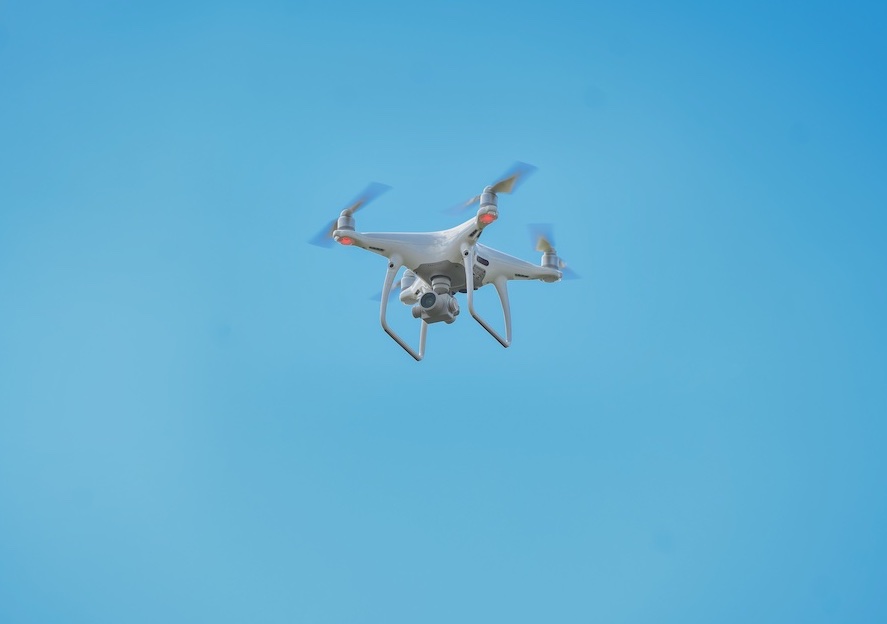
FURTHER AFIELD: When Aerospace launched its newest concentration in 2015, its top business application seemed clear. The devices that hobbyists were calling drones—known in the industry as unmanned aircraft systems (UAS)— would allow farmers to monitor and assess their crops remotely, driving the next wave in precision agriculture. But UAS is a “discipline that can support many other disciplines.” (Click to read more.)
The Unmanned Aircraft Systems (UAS) concentration, which is eight years old and still growing, also will gain a new lab in the former Air Traffic Control simulator space, since that certification program has been phased out and a smaller simulator is being added for a Flight Dispatch course.
Prelis also hopes to launch a doctorate program in education or leadership within the next five years. That would make MTSU one of a select few American universities to offer an aerospace Ph.D., he said.
And even as Aerospace expands its geographic footprint 21 miles to Shelbyville soon, Prelis is looking another 60 miles down the road to Huntsville, Alabama, potential site of the U.S. Air Force Space Command.
At some point I would like to have conversations with the space side of things, as well,” he said. “I think between Huntsville and Nashville there’s plans for an aerospace and space corridor.
When you’re plotting the course for Aerospace—an 80-year-old department that’s doubled its enrollment in the past eight years— it makes sense to take the long view.

COMMENTS ARE OFF THIS POST